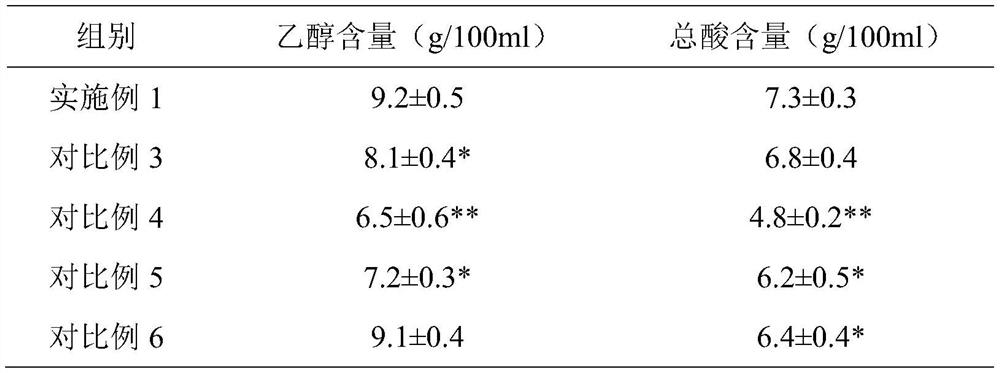A hangover vinegar and its preparation method and application
A wine vinegar and decanting technology, which is applied in the preparation of vinegar, biochemical equipment and methods, microorganism-based methods, etc., can solve the problems of insufficient extraction of active ingredients, poor functional synergy, etc., to promote dissolution and utilization, and reduce GSH. consumption, the effect of promoting the sobering effect
- Summary
- Abstract
- Description
- Claims
- Application Information
AI Technical Summary
Problems solved by technology
Method used
Image
Examples
Embodiment 1
[0055] Embodiment 1: the preparation of hangover vinegar
[0056] A hangover vinegar prepared according to the following method:
[0057] (1) Raw material preparation: 80 parts of fresh corn are crushed and beaten and added to 70 parts of millet and 60 parts of sorghum. The total mass of corn, millet and sorghum is mixed with water according to the mass volume ratio of 1:2 (m / v), soaked in water at 30 °C 24 hours later and set aside; 20 parts of Hovenia dulcis, 8 parts of turmeric, and 8 parts of wolfberry were crushed into powder, and sieved through a 40-mesh sieve for use;
[0058] (2) Cooking and liquefaction: Cook the drained corn, millet and sorghum at 100°C for 20 minutes, cool down to 80°C, add 0.05% (v / m) high-temperature-resistant amylase enzyme solution, and keep warm for 30 minutes; continue Cool to 55°C, add 0.05% (v / m) cellulase enzyme solution, keep warm for 35 minutes, hydrolyze starch and cellulose in raw materials; the enzyme activity of high temperature resi...
Embodiment 2
[0070] Embodiment 2: the preparation of hangover vinegar
[0071] A hangover vinegar prepared according to the following method:
[0072] (1) Raw material preparation: 90 parts of fresh corn are crushed and beaten into 80 parts of millet and 50 parts of sorghum. The total mass of corn, millet and sorghum is mixed with water in a ratio of 1:3 (m / v) by mass and volume, and placed in water at 28 °C Soak for 36 hours and set aside; 15 parts of Hovenia dulcis, 5 parts of turmeric, and 10 parts of Chinese wolfberry are crushed into powder, and sieved through a 40-mesh sieve for use;
[0073] (2) Cooking and liquefaction: Cook the drained corn, millet and sorghum at 95°C for 25 minutes, cool down to 90°C, add 0.04% (v / m) high-temperature-resistant amylase enzyme solution, and keep warm for 35 minutes; continue Cool to 60°C, add 0.04% (v / m) cellulase enzyme solution, keep warm for 30 minutes, hydrolyze starch and cellulose in raw materials; the enzyme activity of high temperature res...
Embodiment 3
[0085] Embodiment 3: the preparation of hangover vinegar
[0086] A hangover vinegar prepared according to the following method:
[0087] (1) Raw material preparation: 100 parts of fresh corn are crushed and beaten into 60 parts of millet and 40 parts of sorghum. The total mass of corn, millet and sorghum is mixed with water in a ratio of 1:4 (m / v) by mass and volume, and placed in water at 25°C After soaking for 48 hours, set aside; 10 parts of Hovenia dulcis, 10 parts of turmeric, and 5 parts of Chinese wolfberry are crushed into powder, and sieved through a 40-mesh sieve for use;
[0088] (2) Cooking and liquefaction: Cook the drained corn, millet and sorghum at 90°C for 20 minutes, cool down to 70°C, add 0.06% (v / m) high-temperature-resistant amylase enzyme solution, and keep warm for 40 minutes; continue Cool to 58°C, add 0.06% (v / m) cellulase enzyme solution, keep warm for 40 minutes, hydrolyze starch and cellulose in raw materials; the enzyme activity of high temperatu...
PUM
 Login to View More
Login to View More Abstract
Description
Claims
Application Information
 Login to View More
Login to View More - R&D
- Intellectual Property
- Life Sciences
- Materials
- Tech Scout
- Unparalleled Data Quality
- Higher Quality Content
- 60% Fewer Hallucinations
Browse by: Latest US Patents, China's latest patents, Technical Efficacy Thesaurus, Application Domain, Technology Topic, Popular Technical Reports.
© 2025 PatSnap. All rights reserved.Legal|Privacy policy|Modern Slavery Act Transparency Statement|Sitemap|About US| Contact US: help@patsnap.com



